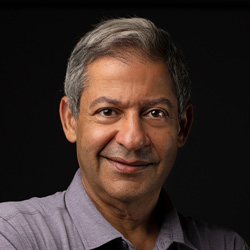Pairing Social Networks with Social Motives to Close the Science Gap
Noshir Contractor and his collaborators are studying how to use networks to spread messages about public health knowledge
Scientists make discoveries everyday, but that doesn’t mean the findings are put into common practice.
In India, for example, the neonatal mortality rate is 10 times higher than in the developed world. While clinical trials found that applying an inexpensive topical solution of chlorhexidine to cleanse a newborn’s umbilical cord reduced the neonatal mortality rate by 24 percent, many Indian parents did not receive or follow this information.
“The challenge is not that we don’t have solutions to solve major societal problems, but that we struggle with how to take a known solution and get a large number of people to use it,” said Northwestern University Professor Noshir Contractor. “There is a big gap between what science offers us and what gets applied.”

Contractor is the Jane S. and William J. White Professor of Behavioral Sciences and professor of industrial engineering and management sciences in the McCormick School of Engineering, professor of communication studies in the School of Communication, and professor of management and organizations at the Kellogg School of Management. He is an expert on social networks, structures composed of interactions among individuals or organizations.
The ongoing study is described in the paper “Integrating social networks and human social motives to achieve social influence at scale” in the September 15 issue of the Proceedings of the National Academy of Sciences.
In an earlier project funded by the Bill & Melinda Gates Foundation, Contractor surveyed government officials in India to determine which people were most influential both inside their district and among outside districts. By leveraging those influential people, Contractor found that networks could be used to spread valuable information about public health. In this Gates-funded follow-up project, Contractor is now exploring how to craft messages for these influential people to spread.
The research team also includes Michelle Shumate, associate professor of communications studies in the School of Communication; Paul Leonardi (formerly of Northwestern), professor of technology management at the University of California at Santa Barbara; and Larry Prusak, an independent consultant on knowledge management.
“You think you can just tell someone the scientific facts, and that will solve the problem,” he said. “There is very good evidence that it doesn’t solve the problem at all because personal beliefs interfere.”
In the case of chlorhexidine, for example, some parents are hesitant to use it because of deep-rooted traditional beliefs dating back several centuries that encourage parents to apply mustard oil to the umbilical cord. Some parents worry that breaking the ritual will cause bad luck for their child.
“It’s like the sports fans who always wear the same lucky shirt,” Contractor said. “You can tell them as much as you want that wearing the same shirt will not help their team, but they are still going to do it.”
Contractor and DeChurch realized that for one person to persuade another person, it is important to have information about how their motives affect what information they believe. People tend to fall into one of two different categories: the need to be right or the need to be liked. People who want to be right respond more to scientific data and perspectives from well-respected opinion leaders. People who want to be liked respond more to the opinions of people they trust or to whom they feel an obligation.
To find out which people fall into each category, Contractor is leading a survey of 14,000 family health workers in India. The paper-based survey involves family health workers for the Indian government as well as several non-profit organizations and development partners.
“We are asking them about who they go to for advice on family health solutions as well as questions that will help us assess the extent to which these people are driven by the need to be right or the need to be liked,” Contractor said. “Based on those characteristics, we can identify who is most likely to influence them and what message is most likely to influence them.”
The results of the survey will be implemented in a digital dashboard that Contractor calls the “Do Board.” Members in a technical support unit from the non-governmental organization Care India will possess the Do Boards, using the information to help health officials interested in scaling up innovations identify who is likely to influence whom and with what message.
“A lot of people think that networks just make pretty pictures and nice visualizations,” Contractor said. “We want to prove that networks can do something very actionable and solve major world problems.”